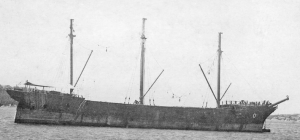Coal Hulk Hankow
| Builder |
Alexander Stephen & Sons Ltd, Glasgow, Scotland |
|---|---|
| Fate |
Sunk by HMAS Albatross’s 4-inch guns on 18 September 1932 |
The coal hulk Hankow, formerly the clipper ship City of Hankow, was acquired by the Royal Australian Navy (RAN) in July 1913. Built as a composite clipper ship (iron frame with teak planking), the City of Hankow was constructed at Glasgow, Scotland, in 1869 by Alexander Stephen & Sons Ltd for George Smith & Sons of Glasgow. She operated on the England to India run for several decades carrying passengers and cargo. In 1900 she was sold to GJ Robertson & Partners of Sydney who continued to operate her as a trading vessel. Her last journey was in 1903 when she transported a cargo of timber from Eureka, California, to Sydney. She was then stripped down and sold in 1904 to the Royal Navy for use as a coal hulk and stores ship in Sydney Harbour by the Australian Squadron.





